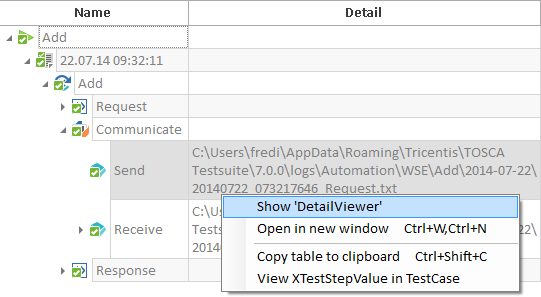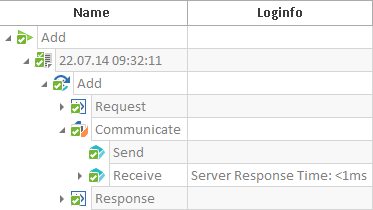
|
As of Tricentis Tosca 12.2, the Webservice Engine 3.0 is no longer supported. By default, you cannot create WSE TestCases in API Scan. For information on how to re-enable scanning WSE TestCases in API Scan, see chapter "Web service". |
This chapter describes Webservice Engine specific test configuration parameters and log information.
Requests and Responses can be saved as an HTTP message in a text file to search for errors (logging). This requires the test configuration parameter WebserviceEngineLogRequestResponse to be defined.

Test configuration parameter WebserviceEngineLogRequestResponse
If the test configuration parameter is defined and if its value is True, a request and a response are each saved as a text file to the directory that is defined by the setting Request/Response log directory. By default the directory is as follows: %APPDATA%\Tricentis\Tosca Testsuite\7.0.0\logs\Automation\WSE. The time of sending or receiving, the HTTP header and the content of the message are displayed in the text file.
The file name consists of the following:
<yyyyMMdd_hhmmssfff>_<Request|Response>.txt
If a TestCase is executed via the Scratchbook, the ExecutionEntry is not included in the file name.
Once a test has been executed, the ExecutionList in the Execution section displays the path to the created file in the ExecutionEntry for Send and Receive in the column Detail. The file can be opened directly by selecting the option Show 'DetailViewer' from the context menu of the entry (see chapter "Open files you created during execution").

Path to the text file in the Detail column

|
The Modules Save Request and Save Response are used in the TestStepValues Transform request and Transform response in order to save requests and responses in their original format (see chapter "Saving requests and responses"). |
The test configuration parameter WebserviceEngineResponseTimeout is created to set the response timeout locally. The setting ResponseTimeout is used to change the timeout in general. This setting shows how long it takes for a Webservice to respond. The timeout is displayed in milliseconds.

Configuration parameter ResponseTimeout
Server Response Time
After execution, the response time of the server is shown in the ExecutionEntry of the TestStepValue Receive, in the Loginfo column. This information can be used in order to identify reasons for long execution times.

|
In this example, the time spent on the server is less than 1 millisecond.
Example - Server Response Time |
